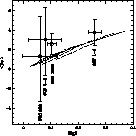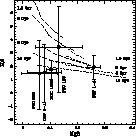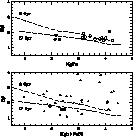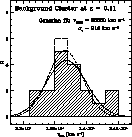 |
We defined 4 classes of quality due to the clearness and evidence of the velocity identification: (1) a clear and evident identification, both methods agree very well, (2) very probable identification, almost clear, (3) doubtful, but most probable value, and (4) very doubtful, only a try.
Table 3 summarises the statistics of quality classes divided into the following sub-samples: velocities between 700 and 2500 km s-1 (Fornax cluster, not including the galaxies of Table 1), velocities between 33000 and 34500 km s-1 (background cluster, see Sect. 5.3), and all other background galaxies.
In Fig. 3 we show the selection of our sample in a
![]() diagram (see also Paper I, Figs. 3 and 7). All
velocity determinations of the quality classes
1 to 3 are indicated. The limits are
diagram (see also Paper I, Figs. 3 and 7). All
velocity determinations of the quality classes
1 to 3 are indicated. The limits are ![]() mag and
mag and ![]() mag arcsec-2.
The velocities of the fainter galaxies are mainly based on
emission line identifications. Due to the low surface brightness of most
dwarf galaxies (FCC numbers) the signal-to-noise of their spectra is too
low for line identifications. Among the galaxies with higher surface
brightness two objects with velocities consistent with Fornax members
were found.
mag arcsec-2.
The velocities of the fainter galaxies are mainly based on
emission line identifications. Due to the low surface brightness of most
dwarf galaxies (FCC numbers) the signal-to-noise of their spectra is too
low for line identifications. Among the galaxies with higher surface
brightness two objects with velocities consistent with Fornax members
were found.
The distribution of velocities in our sample is shown in Fig. 4.
The first bin represents the Fornax cluster velocities. The highest
velocity (cz = 97000 km s-1) corresponds to a redshift of z = 0.3.
A striking feature is the concentration of galaxies around 33700 km s-1
(z = 0.11).
They belong to a background cluster behind the center of the
Fornax cluster (see Sect. 5.3). Another group of galaxies with velocities around
26000 km s-1 is concentrated in a region about ![]() east of
NGC 1399 (field B1; see Paper I). The galaxies around 55000 km s-1 are not
spatially correlated.
east of
NGC 1399 (field B1; see Paper I). The galaxies around 55000 km s-1 are not
spatially correlated.
Our velocity sample includes 12 galaxies studied before. Table 4 gives the different names, membership classifications, and previous radial velocity measurements.
Irwin et al. (1990) had no morphological classification
for their targets,
but noted that their compilation of low surface brightness
galaxies, which they classified as members (Davies
et al. 1988), might be contaminated by background galaxies in
the magnitude range 17 < B < 19 mag and of central surface brightnesses of
![]() 22.5 mag/arcsec2. Indeed, all galaxies in this range
turn out to be background galaxies (CGF 9-1, CGF 3-6,
and CGF 1-10). Concerning the FCC, all "likely background'' galaxies
are proved to be true background galaxies (CGF 9-1, CGF 3-7, and CGF 10-2).
In addition, the likely Fornax member FCC 141 (CGF 9-5) has a velocity of
22.5 mag/arcsec2. Indeed, all galaxies in this range
turn out to be background galaxies (CGF 9-1, CGF 3-6,
and CGF 1-10). Concerning the FCC, all "likely background'' galaxies
are proved to be true background galaxies (CGF 9-1, CGF 3-7, and CGF 10-2).
In addition, the likely Fornax member FCC 141 (CGF 9-5) has a velocity of
![]() km s-1. Due to its blue color,
(V - I) = 0.8 mag, it was classified as irregular.
The definite FCC galaxies are confirmed to be members. Their velocities agree
well with previous results.
km s-1. Due to its blue color,
(V - I) = 0.8 mag, it was classified as irregular.
The definite FCC galaxies are confirmed to be members. Their velocities agree
well with previous results.
Recently, Minniti et al. (1998) have measured radial
velocities of globular clusters
around NGC 1399. Their brightest object, whose nature as GC was questionned,
is the same as the nucleus-like
object CGF 1-4 (see next section). Their velocity of ![]() km s-1 agrees very well with our value:
km s-1 agrees very well with our value: ![]() km s-1.
km s-1.
 |
In order to investigate the possibility, whether these two objects might
be "normal'' GCs in a very rich GCS, the number of GCs that populate
the bright end of the luminosity function (LF) of the GCS in NGC 1399 was
estimated in Monte Carlo simulations.
As representation of the LF both a Gaussian and a t5-function
(see e.g. Kohle et al. 1996) with different dispersions
![]() were adopted. In 100 runs 5800 GCs were randomly distributed. In
Table 5 the number counts in 6 bright bins (bin width 0.5 mag) are
given for different functions and dispersions.
Very bright GCs with MV = -13.3 mag can statistically
exist in a rich GCS, if the t5-function is representative for the bright
wing of the LF.
were adopted. In 100 runs 5800 GCs were randomly distributed. In
Table 5 the number counts in 6 bright bins (bin width 0.5 mag) are
given for different functions and dispersions.
Very bright GCs with MV = -13.3 mag can statistically
exist in a rich GCS, if the t5-function is representative for the bright
wing of the LF.
According to numerical simulations by Bassino et al.
(1994) nuclei of nucleated
dwarf galaxies can survive the dissolution in the gravitational field of a
giant elliptical over the lifetime of the universe. They expect
globular-cluster-like remnants and less concentrated remnants with
masses in the range between 2.8 to ![]() and tidal radii from
170 to 400 pc.
and tidal radii from
170 to 400 pc.
Assuming that the two nucleus-like objects have mass-to-light ratios
resembling GCs, their masses can be estimated.
Adopting the relation of Mandushev et al. (1991),
log![]() , we derive masses of
, we derive masses of ![]() and
and ![]() respectively.
This is one order of magnitude more massive than
respectively.
This is one order of magnitude more massive than ![]() Centauri
(
Centauri
(![]() ), the most massive cluster in the Milky Way.
Alternatively, the mass of both objects can be compared with that of
M 32. Nolthenius & Ford (1986) derived a mass of about
), the most massive cluster in the Milky Way.
Alternatively, the mass of both objects can be compared with that of
M 32. Nolthenius & Ford (1986) derived a mass of about
![]() and a M/LB = 3-4 from velocity dispersion measurements. If we adopt
a mass-to-light ratio of 3.5 for the two compact objects, we get masses of
and a M/LB = 3-4 from velocity dispersion measurements. If we adopt
a mass-to-light ratio of 3.5 for the two compact objects, we get masses of
![]() and
and ![]() , more than one magnitude
less massive than M 32.
, more than one magnitude
less massive than M 32.
The third object that has the velocity of the Fornax cluster, CGF 7-9, is
located about ![]() north-east of NGC 1427A. Its velocity is
very uncertain (Q = 4). Nevertheless, in case of membership, this galaxy
belongs to the late-type dwarf population due to its blue color ((V - I)
= 0.9) and irregular shape.
north-east of NGC 1427A. Its velocity is
very uncertain (Q = 4). Nevertheless, in case of membership, this galaxy
belongs to the late-type dwarf population due to its blue color ((V - I)
= 0.9) and irregular shape.
 |
Figure 5:
Mg2 is plotted versus the equivalent width of
<Fe> = (Fe5270+Fe5335)/2. The filled circles are the nucleus-like
objects CGF 1-4 and CGF 5-4. Open circles are the dE, Ns FCC 122 and NGC
1396. The dashed lines are tracks from population synthesis models for
single stellar populations (long dashed: Fritze-v. Alvensleben & Burkert
1995, short dashed: Worthey 1994). The age
range is 1.5 to 17 Gyr, the metallicity range |
Metal abundances of the three dE, Ns NGC 1396, FCC 188, and FCC 222
and the two nucleus-like objects were measured in order to compare them with
the properties of Milky Way, LMC and NGC 1399 GCs.
The procedure for the measurement of the line indices is described in
Brodie & Huchra (1990). The Lick/IDS bandpasses were
used, as defined by Burstein et al. (1984) and updated by
Trager (1997). In Table 6 the indices, given in
magnitudes and measured on the unfluxed spectra, are summarised. In the
Figs. 5, 6, and 7 the line indices of H![]() ,<Fe>, MgFe, and Mgb
,<Fe>, MgFe, and Mgb![]() Fe52 are converted into equivalent widths by
the relation
Fe52 are converted into equivalent widths by
the relation ![]() ,where
,where ![]() and
and ![]() are the maximum and minimum wavelengths of
the bandpass. The errors were estimated from the photon noise in the
bandpasses,
are the maximum and minimum wavelengths of
the bandpass. The errors were estimated from the photon noise in the
bandpasses, ![]() , where
, where ![]() ,
, ![]() , and
, and
![]() are the statistical errors in the line and adjacent
continuum bandpasses (see Brodie & Huchra 1990). The
statistical error in the flux in a bandpass is
are the statistical errors in the line and adjacent
continuum bandpasses (see Brodie & Huchra 1990). The
statistical error in the flux in a bandpass is ![]() ,where O and S are the total accumulated counts in the bandpass in the
object and sky, respectively.
,where O and S are the total accumulated counts in the bandpass in the
object and sky, respectively.
 |
Figure 6:
H |
In Fig. 5 and Fig. 6 we plotted Mg2 versus the equivalent
widths of <Fe> (= (Fe5270 + Fe5335)/2) and H![]() ,respectively. The dE, N FCC 188 was omitted in the Mg2-<Fe> plot, since
the iron lines in this spectra are too weak. Also plotted are the relations
for the indices as derived from population synthesis models for single
stellar populations. The long dashed lines are the models from
Fritze-v. Alvensleben & Burkert (1995) for 1.5 to 16 Gyr
old populations, with metallicities between Z = 0.001 and Z = 0.04.
Short dashed lines are Worthey's (1994)
models for 1.5 to 17 Gyr and
,respectively. The dE, N FCC 188 was omitted in the Mg2-<Fe> plot, since
the iron lines in this spectra are too weak. Also plotted are the relations
for the indices as derived from population synthesis models for single
stellar populations. The long dashed lines are the models from
Fritze-v. Alvensleben & Burkert (1995) for 1.5 to 16 Gyr
old populations, with metallicities between Z = 0.001 and Z = 0.04.
Short dashed lines are Worthey's (1994)
models for 1.5 to 17 Gyr and ![]() to 0.5 dex.
to 0.5 dex.
The larger errors (due to the low signal-to-noise of the spectra) do not allow
an age separation of the objects. Notice that the nuclei of the dE, Ns
and CGF 5-4 fall in the range of metal-poor old single stellar populations.
Similarly, metal-poor GCs in the Milky Way and M 31 (Burstein
et al. 1984; Brodie & Huchra 1990) as well as
in NGC 1399 (Kissler-Patig et al. 1998) are located in
this region of the plot. On the other hand, in this diagram CGF 1-4 is
clearly separated from these objects and shows a more metal-rich stellar
population. Its line indices are comparable to those of the metal-rich GCs
in the MW, M 31, and NGC 1399 as well as the line indices of the center of
M 32 (Burstein et al. 1984), which shows a slight
enhancement of H![]() compared to GCs.
compared to GCs.
 |
Figure 7:
[MgFe] versus H |
Adopting the Mg2![]() relation from Brodie & Huchra
(1990), the 4 more metal-poor objects have metallicities
that range between
relation from Brodie & Huchra
(1990), the 4 more metal-poor objects have metallicities
that range between ![]() and -0.9 dex.
This agrees well with the spectroscopic measurements of 10 dE, Ns in Fornax
by Held & Mould (1994).
The metallicity of CGF 1-4 is
and -0.9 dex.
This agrees well with the spectroscopic measurements of 10 dE, Ns in Fornax
by Held & Mould (1994).
The metallicity of CGF 1-4 is ![]() dex, when adopting the
Mg2 - [Fe/H]
relation by Brodie & Huchra (1990), or
dex, when adopting the
Mg2 - [Fe/H]
relation by Brodie & Huchra (1990), or ![]() dex considering
the non-linear behaviour of Mg at higher metallicities (Worthey
1994; Kissler-Patig et al. 1998).
dex considering
the non-linear behaviour of Mg at higher metallicities (Worthey
1994; Kissler-Patig et al. 1998).
Finally, we show in Fig. 7 a comparison between the abundances of
the dwarf galaxies and elliptical galaxies in Fornax measured by
Kuntschner & Davies (1998) (upper panel), as well as dwarf
galaxies in Virgo (taken from Huchra et al. 1996) and globular
clusters in NGC 1399 (taken from Kissler-Patig et al. 1998)
(lower panel). The [MgFe] index (![]() ) was
plotted versus H
) was
plotted versus H![]() , following Kuntschner & Davies. The Virgo dwarfs
have no Fe5335 index measured. For them and the NGC 1399 GCs
, following Kuntschner & Davies. The Virgo dwarfs
have no Fe5335 index measured. For them and the NGC 1399 GCs ![]() (labeled [Mgb
(labeled [Mgb![]() Fe52]) was plotted versus
H
Fe52]) was plotted versus
H![]() . In both panels models from Worthey (1994) for 17 and
8 Gyr, spanning a metallicity range [Fe/H] from -2.0 to 0.5 dex, are
shown for reference. The large errors in our measurement prevent a detailed
comparison; age differences cannot be discriminated within a factor of 2 or
3. However, we note that, as expected,
the dwarf galaxies (except CGF 1-4) are less metal rich than the
giant ellipticals and consistent with having similar ages.
The comparison with the Virgo dwarf galaxies and the NGC 1399 GCs shows
that all the Fornax dwarfs (including CGF 1-4) fall in ranges span by them.
However, CGF 1-4 is more metal
rich than the bulge-like GCs in NGC 1399, and could belong
to the "very metal rich'' group of GCs found by Kissler-Patig
et al. (1998). In this case, it might also be somewhat younger,
which would increase its mass-to-light ratio and reduce the estimated mass.
But CGF 1-4 and CGF 5-4 remain puzzling objects; it can not yet be decided
whether they are nuclei of disrupted dwarf galaxies, cEs, or true extremely
massive GCs. Further spectroscopic observations with a higher
signal-to-noise are needed to uncover the nature of these objects.
. In both panels models from Worthey (1994) for 17 and
8 Gyr, spanning a metallicity range [Fe/H] from -2.0 to 0.5 dex, are
shown for reference. The large errors in our measurement prevent a detailed
comparison; age differences cannot be discriminated within a factor of 2 or
3. However, we note that, as expected,
the dwarf galaxies (except CGF 1-4) are less metal rich than the
giant ellipticals and consistent with having similar ages.
The comparison with the Virgo dwarf galaxies and the NGC 1399 GCs shows
that all the Fornax dwarfs (including CGF 1-4) fall in ranges span by them.
However, CGF 1-4 is more metal
rich than the bulge-like GCs in NGC 1399, and could belong
to the "very metal rich'' group of GCs found by Kissler-Patig
et al. (1998). In this case, it might also be somewhat younger,
which would increase its mass-to-light ratio and reduce the estimated mass.
But CGF 1-4 and CGF 5-4 remain puzzling objects; it can not yet be decided
whether they are nuclei of disrupted dwarf galaxies, cEs, or true extremely
massive GCs. Further spectroscopic observations with a higher
signal-to-noise are needed to uncover the nature of these objects.
 |
Figure 8: Velocity histogram for background cluster galaxies. The velocity dispersion is typical for a relatively poor galaxy cluster |
19 galaxies with velocities around 33700 km s-1 (Fig. 8) were found. The velocity dispersion is about 360 km s-1 which is typical for poor clusters (e.g. den Hartog & Katgert 1996). The ratio of early type (E+S0) to late type (S+Irr) giant galaxies is about 1.1. It is slightly lower than in the Fornax cluster. The spatial distribution of the 19 galaxies is shown in Fig. 9 (bold hexagons). It matches well the density distribution of the fainter galaxies down to V = 21.5 mag; see Fig. 9 in Paper I. Since no countable amount of new Fornax dwarf galaxies was found, we conclude that the excess population of galaxies near NGC 1399 mainly belongs to the background galaxy cluster.
Assuming a Hubble constant of H0 = 75 km s-1 Mpc-1
the distance to the cluster is 450 Mpc, or (m - M)V = 38.3 mag.
The brightest cluster galaxy (CGF 1-1), located ![]() south of NGC 1399,
would then have an absolute luminosity comparable to NGC 1399 (MV = -22.1
mag). Note that the K-corrections at this redshift are in the order of 0.15 mag
in V for old stellar populations and 0.05 mag for late-type spirals
(Coleman et al. 1980).
The radial surface brightness profile of this galaxy (see Paper I, Fig. 4)
follows a de
Vaucouleur profile in the inner part and becomes significantly flatter outside
a radius of
south of NGC 1399,
would then have an absolute luminosity comparable to NGC 1399 (MV = -22.1
mag). Note that the K-corrections at this redshift are in the order of 0.15 mag
in V for old stellar populations and 0.05 mag for late-type spirals
(Coleman et al. 1980).
The radial surface brightness profile of this galaxy (see Paper I, Fig. 4)
follows a de
Vaucouleur profile in the inner part and becomes significantly flatter outside
a radius of ![]() (
(![]() kpc), which is typical for a cD galaxy
(e.g. Schombert 1986).
kpc), which is typical for a cD galaxy
(e.g. Schombert 1986).
The luminosity and color distribution of the galaxies were analyzed inside a trapezium-like region that encloses the member galaxies of the background cluster (see Fig. 9). The distribution of an arbitrary sample of field galaxies around the other Fornax giant galaxies was subtracted from the distribution of the cluster galaxies.
A dip in the luminosity distribution at V = 19.5 was found that
corresponds to an absolute magnitude of about MV = -18.8 mag at a redshift
of z=0.11. This is the luminosity range where the Gaussian shaped giant
galaxy luminosity function decreases and the counts of dwarf galaxies start
to rise (see e.g. Jerjen & Tammann 1997). Of course, the
dwarf galaxy counts are severely uncomplete at the cluster distance
due to their very small angular diameters below our resolution limit
(![]() kpc). However, at the fainter counts, an excess
population of blue, (V - I) < 0.8 mag, dwarf galaxies was found, which
probably represents a population of star-forming dwarf irregulars in the
cluster. Most of these galaxies are clustered around the brightest cluster
galaxy (CGF 1-1) and around a bright elliptical in the north-east of the
cluster (CGF 2-2).
kpc). However, at the fainter counts, an excess
population of blue, (V - I) < 0.8 mag, dwarf galaxies was found, which
probably represents a population of star-forming dwarf irregulars in the
cluster. Most of these galaxies are clustered around the brightest cluster
galaxy (CGF 1-1) and around a bright elliptical in the north-east of the
cluster (CGF 2-2).
The galaxy CGF 2-2 is already known as a narrow-line radio galaxy (Carter & Malin 1983). It is correlated with the radio source PKS 0336-35. Its spectrum shows strong OII, NeIII, and NeV emission lines that Carter & Malin explained by a very bright high-excitation emission-line nucleus. Some of the blue faint galaxies in the direct environment of this galaxy have knots and tails. We propose that CGF 2-2 is the center of an interacting subgroup of galaxies within the background cluster.
In further investigations, this cluster might be used to constrain the amount of extinction within the central part of the Fornax cluster.
Copyright The European Southern Observatory (ESO)